India’s history, geography, and religious traditions have shaped its rich and varied cultural heritage. India is one of the largest and most populous countries in the world, with over 1.3 billion people. Its cultural diversity reflects the diverse regional, linguistic, and religious backgrounds of its people. Indian culture is a fascinating and ever-changing aspect of its identity. It includes delicious food, vibrant music and dance traditions, colorful festivals, and ancient religious practices. You will be struck by the diversity and richness of Indian culture, and you will leave with a deeper appreciation for this one-of-a-kind and fascinating country. You will be able to participate in its lively festivals, try its spicy food, and learn about its fascinating history.
Religion
Many Indians’ culture and daily lives are heavily influenced by religion. Hinduism is the most widespread religion in India, followed by Sikhism, Buddhism, Christianity, Islam, and Jainism. Indian culture and daily life are significantly influenced by the beliefs, practices, and sacred texts of each religion.
Hinduism is a religion that dates back thousands of years and has a long and varied history. It is based on the idea that people reincarnate and that the ultimate goal is to achieve moksha, or freedom from the rebirth cycle. Hinduism also has a large number of gods and goddesses in its pantheon, each with their own stories, personalities, and powers.

On the other hand, the teachings of the prophet Muhammad as recorded in the Quran and the belief in a single God are the foundations of Islam. It is a monotheistic religion that stresses the significance of community, charity, and prayer.
Christianity is a minority religion in India, with a significant presence in parts of northeastern India and the southern state of Tamil Nadu. It is centered on the belief that one can be saved by faith in Jesus Christ and is based on what the Bible says about his teachings.

Founded in northern India in the 16th century, Sikhism is a monotheistic religion. Equality, social justice, and the significance of personal devotion to God are all emphasized.
Based on the teachings of the Buddha, also known as the “Enlightened One,” Buddhism, which originated in India, places an emphasis on spiritual growth and the path to enlightenment.

A religion that also originated in India, Jainism emphasizes self-control, nonviolence, and the importance of separating oneself from material desires.
Religion is often deeply entwined with a person’s cultural and social identity in India, where it occupies a central place in people’s lives. Religion is an important part of Indian culture. It helps to bring people together and strengthen social ties through daily prayers, festivals, and community events.
Cuisine
One of the most varied and flavorful cuisines in the world is Indian, which is a reflection of the country’s extensive cultural heritage as well as regional, religious, and historical influences. Indian food is a sensory experience that is adored by people all over the world. This is because of the unique cooking methods and spices used in the cuisine.

Spices and herbs like ginger, chili peppers, cumin, coriander, turmeric, and coriander are frequently used in Indian cuisine. Curries, biryanis, and stews are just a few of the many dishes made with these spices that are both flavorful and healthy.
Tandoori chicken is one of India’s most well-known dishes. It is cooked in a tandoor, or clay oven, after being marinated in yogurt and spices. Biryani, a flavorful rice dish often made with spices, meat, and vegetables, is another popular dish. Samosas, triangular fried or baked pastries stuffed with vegetables or meat, are a common snack in India and all over the world.

In keeping with the country’s strong tradition of non-violence and respect for all life, Indian cuisine also includes a wide variety of vegetarian dishes. Dal makhani, a creamy lentil dish, and chana masala, a spicy chickpea dish, are two well-liked vegetarian dishes.
Food is more than just food in India; Sharing meals is a significant means of bringing people together and is an essential component of the cultural fabric. Food is a central part of Indian culture and an essential component of the country’s rich and diverse heritage, whether at a family gathering, a religious festival, or a street-side food stall.
Clothing
India’s clothing reflects the country’s diverse regional, religious, and historical influences as well as its rich cultural heritage. Indian clothing is both beautiful and practical, and it plays a significant role in the cultural identity of the nation, from the vibrant saris and intricate henna designs worn by women to the elaborate turbans worn by men.
In India, saris are a form of traditional clothing worn by women. They come in a variety of designs, hues, and materials, from delicate cotton to opulent silk. Saris are typically worn with a blouse and a dupatta, a long scarf, and are typically worn over one shoulder and around the waist.
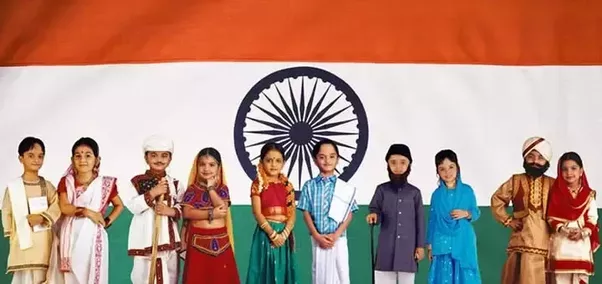
A dhoti, a piece of cloth that is worn around the waist and legs, and a kurta, a long, loose-fitting shirt, are two common items of traditional attire for men. The turban is a common head covering for men in northern India. It is typically wrapped in intricate designs and is typically made of bright and colorful fabric.
Clothing is frequently used to convey social and cultural status, as well as religious or regional identity, in India. For instance, bindis, a small dot worn on the forehead, are worn by women in some parts of India to indicate their marital status, while in others, it is used as a Hinduism symbol.
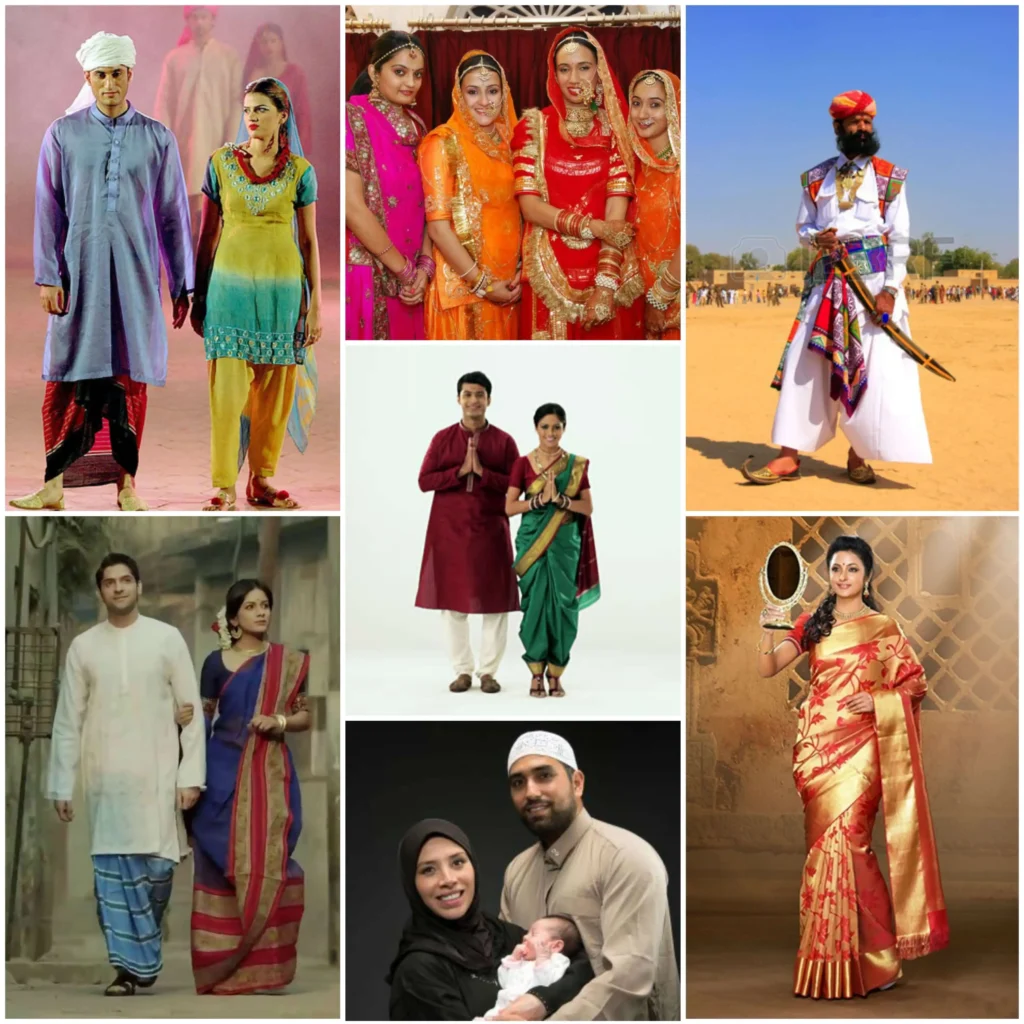
Indian fashion is also influenced by religious beliefs and practices, and a lot of people wear particular clothes when they go to a temple or participate in religious ceremonies. In Hinduism, for instance, it is customary to cover one’s head and wear white or light-colored clothing during prayer, or puja.
Clothing in India is an important part of the country’s cultural identity and reflects the diverse and rich traditions of its people, whether through vibrant saris or intricate turban designs.
Music and Dance
Music and dance are important parts of Indian culture because they show the country’s diverse and rich cultural heritage. In India, music and dance are a way to celebrate life and bring people together. They come in a variety of styles, from classical forms like Bharatanatyam and Kathak to devotional songs and folk dances.
Some of the oldest and most well-established forms of art in the world are classical Indian music and dance, which are deeply ingrained in the history of the nation. For instance, Bharatanatyam is a classical dance form that originated in the southern state of Tamil Nadu and dates back more than 2,000 years. In contrast, Kathak is a classical dance form from northern India that focuses on intricate footwork and movement storytelling.
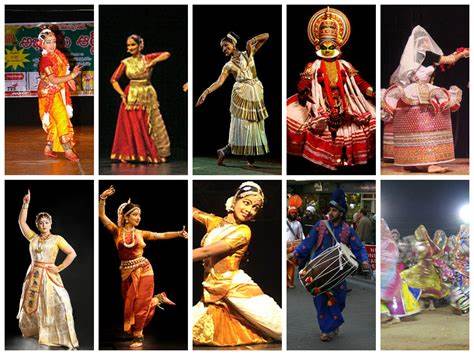
India has a long history of devotional music and singing, and both Hindu and Muslim worship places a significant emphasis on religious songs and hymns. For instance, Qawwali is a type of devotional music that is performed in Sufi shrines and is popular in India and Pakistan.
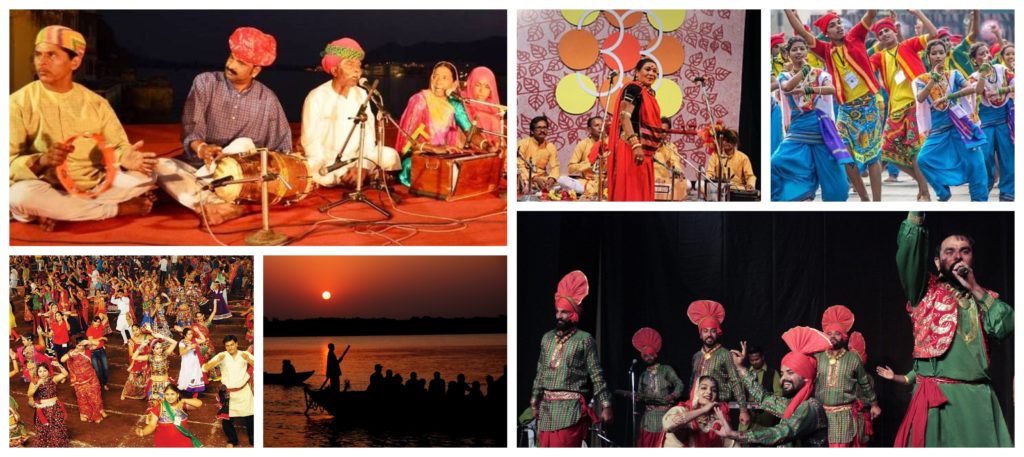
The diverse regional, cultural, and linguistic traditions of the Indian people are reflected in folk music and dance, which also play a significant role in Indian culture. Folk music and dance are an important way for people to connect with their roots and preserve their cultural heritage. Examples of folk music and dance include the high-energy Bhangra dance from Punjab and the vibrant Garba dance from Gujarat.
In India, not only are music and dance used for entertainment and cultural expression, but they also play an important part in social and religious ceremonies. Music and dance are a big part of Indian life and are an important part of the country’s rich and diverse cultural heritage. They can be heard at weddings, religious festivals, family get-togethers, and community celebrations.
Festivals
Festivals are an important part of Indian culture because they bring people together to celebrate the country’s diverse cultural and regional identities, religious practices, and rich heritage. Indian festivals, from the colorful Holi festival to the elaborate Diwali celebration, are a time of celebration, unity, and renewal.
Holi, for instance, is a spring festival that marks the beginning of spring and the triumph of good over evil. Holi is celebrated by throwing colored powder and water at friends and family, dancing, and eating. It is also known as the “festival of colors.”
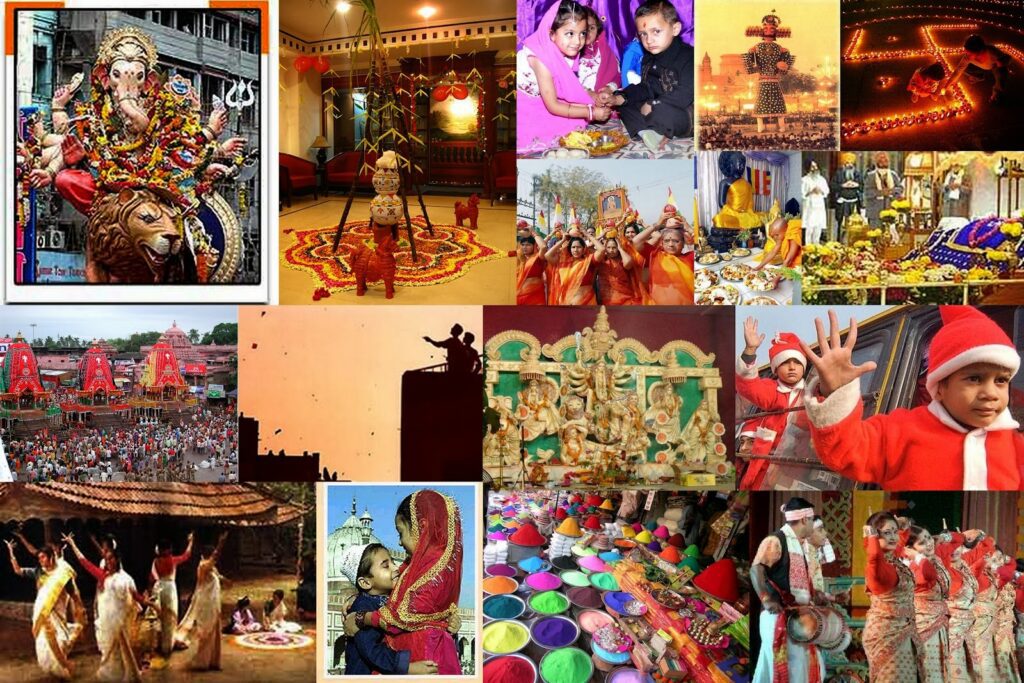
Diwali, on the other hand, is a festival of lights that celebrates the triumph of good over evil and light over darkness. It is celebrated by lighting diyas, which are miniature lamps made of clay, by decorating homes with rangolis, which are intricate floor designs, and by giving gifts to friends and family.
Navaratri, a Hindu festival celebrating the worship of the goddess Durga, and Eid al-Fitr, a Muslim festival celebrating the end of Ramadan, are two other significant festivals celebrated in India. Onam, a harvest festival in Kerala’s southern state, and Pongal, a harvest festival in Tamil Nadu’s southern state, are also celebrated.

India celebrates several secular festivals in addition to religious ones, such as Independence Day, which commemorates the country’s independence from British rule, and Republic Day, which commemorates the adoption of India’s constitution.
Festivals in India bring people together and serve as an important way to celebrate the country’s rich cultural heritage, diverse religious traditions, and regional identities, whether through the colorful and joyful Holi celebration or the elaborate Diwali celebration.
Other Aspects of Culture
Indian culture includes numerous other aspects that contribute to the country’s diverse identity and rich heritage. The following are some important aspects of Indian culture:
Language: With more than 21 officially recognized languages and hundreds of dialects, India is a linguistically diverse nation. The most spoken languages in India are Hindi and English, but regional languages like Bengali, Telugu, and Marathi also play a significant part in Indian culture.
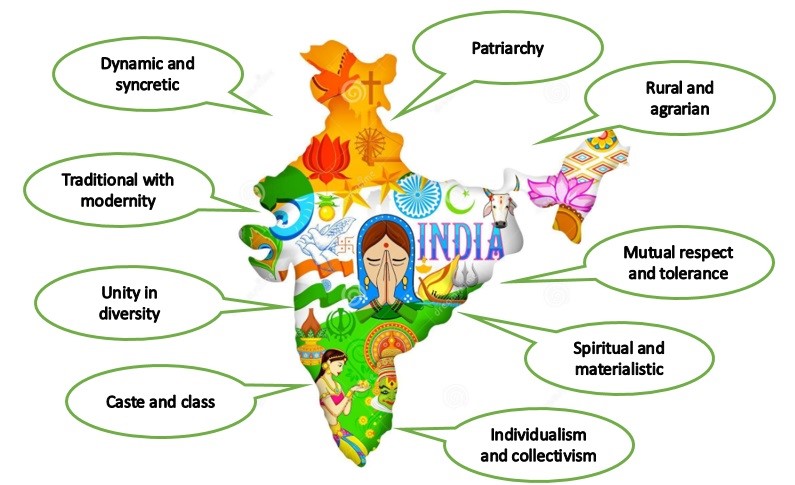
Society and the Family: Indian culture places a strong emphasis on family and community, and extended families frequently reside in close proximity to one another. Love marriages are becoming more accepted, particularly in urban areas, despite the fact that arranged marriages remain prevalent.
Cuisine: Regional specialties like the spicy vindaloo from Goa, the creamy korma from the northern part of India, and the aromatic biryani from Hyderabad are just a few examples of the many flavors and ingredients found in Indian cuisine. Indian cuisine is heavily reliant on spices and herbs, and dishes frequently incorporate a variety of sweet, sour, salty, and spicy flavors.
Crafts and DIY: Traditional forms like embroidery, pottery, weaving, and painting are still widely practiced today in Indian arts and crafts, which have a long history. Indian arts and crafts are a reflection of the country’s rich cultural heritage and diversity, ranging from the intricate details of Madhubani paintings to the delicate beauty of Chikankari embroidery.
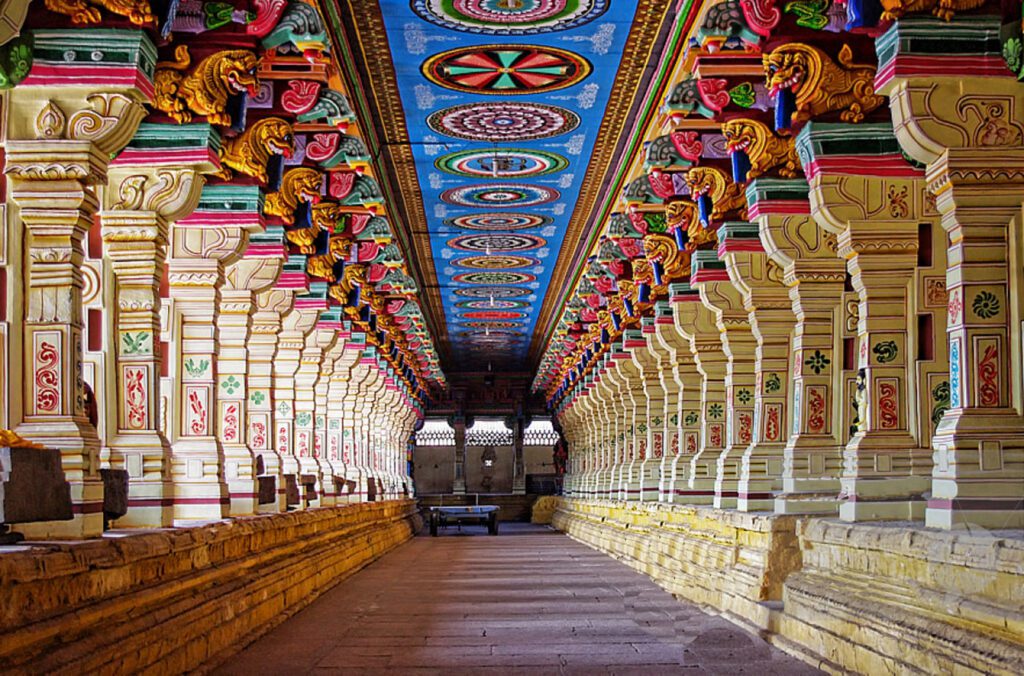
Architecture: Ancient structures like the Taj Mahal and the Hindu temples of Khajuraho reflect India’s rich cultural and religious history. India has a rich architectural heritage. The Victoria Memorial in Kolkata and other Colonial-era structures also contribute to India’s distinctive architectural landscape.
These are just a few of the many aspects that make up the intricate cultural tapestry of India. Indian culture is a celebration of life and a reflection of the country’s rich heritage and diverse identity through its flavorful cuisine, intricate arts and crafts, and numerous religious and linguistic traditions.
Conclusion
Indian culture is a complex and varied mix of beliefs, practices, traditions, and values that have been shaped by the long history and geography of the country. The country is a demonstration of the power of cultural tradition and identity, as evidenced by the vibrant festivals that unite people and the rich architecture, arts and crafts, and cuisine that reflect India’s diverse cultural heritage. India continues to be one of the world’s most vibrant and culturally rich nations despite the numerous difficulties it faces, such as economic inequality, political instability, and regional conflicts. Indian culture continues to educate, entertain, and inspire people from all over the world. It has a long history and a bright future.
FAQs
What is the culture of India?
The traditions, beliefs, values, and practices that have developed over time in India are referred to as Indian culture. It includes festivals, religion, language, cuisine, the arts, music, dance, and cuisine, among other things.
What important aspects of Indian culture are there?
Religion, family and society, cuisine, arts and crafts, architecture, music and dance, and festivals are among the most significant aspects of Indian culture.
How important is religion to Indian culture?
Hinduism, Islam, Christianity, and Sikhism are among the most widely practiced religions in India, all of which play a significant role in the culture of the country. The way people dress, what they eat, the festivals they celebrate, and the values they hold are all influenced by religion in India.
Which Indian festivals are well-known?
India’s vibrant and colorful festivals are a symbol of the country’s diverse identity and rich cultural heritage. Diwali, Holi, Navaratri, and Eid al-Fitr are among India’s most well-known celebrations.
How does Indian food taste?
Regional specialties like the spicy vindaloo from Goa, the creamy korma from the northern part of India, and the aromatic biryani from Hyderabad are just a few examples of the many flavors and ingredients found in Indian cuisine. Indian cuisine is heavily reliant on spices and herbs, and dishes frequently incorporate a variety of sweet, sour, salty, and spicy flavors.
In Indian culture, what roles do society and the family play?
Indian culture places a strong emphasis on family and community, and extended families frequently reside in close proximity to one another. Love marriages are becoming more accepted, particularly in urban areas, despite the fact that arranged marriages remain prevalent.
What are some distinctive features of Indian crafts and arts?
Traditional forms like embroidery, pottery, weaving, and painting are still widely practiced today in Indian arts and crafts, which have a long history. Indian arts and crafts are a reflection of the country’s rich cultural heritage and diversity, ranging from the intricate details of Madhubani paintings to the delicate beauty of Chikankari embroidery.







